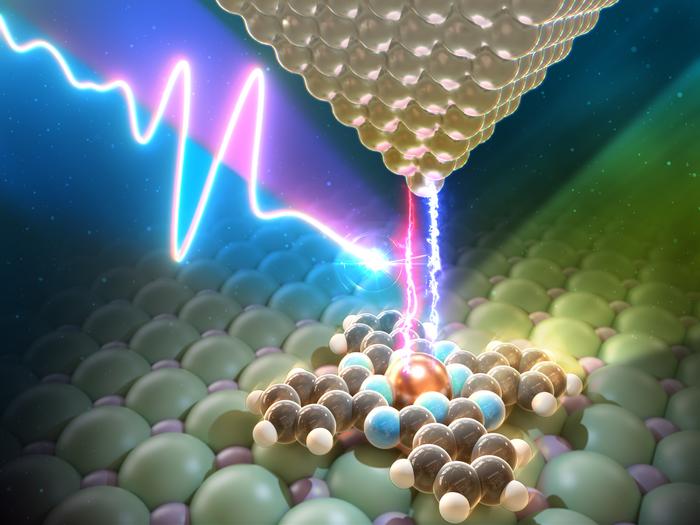
Scientists at YOKOHAMA National University have recently unveiled groundbreaking research that could dramatically impact the fields of electronics, energy transfer, and chemical reactions. This pioneering study, conducted in collaboration with esteemed institutions RIKEN and various academic entities across Japan and Korea, introduces innovative techniques for manipulating electron behavior in molecules using ultrafast, phase-controlled pulses of terahertz light. Published in the renowned journal Science, these findings represent a significant leap in our understanding of molecular dynamics and the potential applications in advanced materials and nanotechnology.
At the atomic level, electrons within molecules live in specific energy configurations akin to layered structures around positively charged atomic nuclei. This electronic arrangement is paramount in dictating a molecule’s physical and chemical properties. This layout influences pivotal processes such as photon emission, inter-molecular charge movement, and the kinetics of chemical reactions.
Moreover, when energy, typically provided by light, is absorbed by an electron, it may jump to a higher energy state, which creates a positively charged vacancy known as a “hole”. This excitation gives rise to what is termed an exciton—a minuscule package of energy that can subsequently release light. Excitons serve as vital agents in technologies such as solar cells, where they facilitate the conversion of sunlight into electrical energy, and light-emitting diodes, which depend on the release of energy as illumination.
While excitons are significant, molecules often exist in numerous other states, including charged states and excited charged states. Charged states occur when there is an electron gained or lost, while charged excited states are characterized by a simultaneous change in charge coupled with the presence of an electron in an elevated energy state. Though crucial for various applications, managing these states, particularly on ultrafast timescales, has posed significant challenges.
Traditional methods utilizing visible light typically lack the necessary energy to induce electronic charge alterations in molecules. Consequently, this limited approach has thwarted efforts to explore the intricacies of electron manipulation at molecular levels. To navigate this barrier, the YOKOHAMA National University research team turned to terahertz light pulses, which operate at a frequency markedly lower than visible light.
These terahertz pulses provide an innovative mechanism whereby electrons can be transferred between a targeted molecule and the metallic probe tip of a specially designed microscope capable of individual molecule manipulation. This technology enables researchers to precisely extract or donate electrons to the molecule, offering a controlled pathway for manipulating excitons and other crucial molecular states.
The emergence of this new technique not only allows for rapid and precise regulation of exciton formation but also paves the way for controlling other essential molecular processes critical for chemical reactions, energy transportation, and various other applications. Furthermore, the research team showcased an unprecedented ability to convert terahertz light—imperceptible to the human eye—into visible light within a molecule. This transformative process illustrates the potential to convert various types of light, linking different spectrums through internal molecular energy transitions.
Professor Ikufumi Katayama, a prominent author of the study, emphasizes the far-reaching implications of these findings. He states, “While excitons typically form when light is absorbed by a material, our findings reveal they can also be created through charged states using these specially designed terahertz pulses. This opens new opportunities for managing charge movements within molecules, which could lead to enhancements in solar cell efficiency, the miniaturization of photonic devices, and faster electronic systems.”
A major achievement highlighted in this research is the ability to control exciton generation at the singular molecular level. Professor Jun Takeda, also a corresponding author affiliated with YOKOHAMA National University’s Faculty of Engineering, elaborates on this innovation. He explains, “By meticulously controlling the movement of electrons between a single molecule and the metallic probe of our advanced microscope, we can orchestrate exciton formation and subsequent chemical reactions. Traditionally, these processes unfolded randomly. However, with the application of terahertz pulses, we can pinpoint exactly when and how reactions transpire at the molecular scale.”
This research opens new vistas in nanotechnology and advanced materials science, ushering in a new page for more efficient catalysts in energy production and industrial applications. Not only does it challenge existing ideas about electron dynamics in molecules, but it also provides a toolkit for exploring uncharted territories in molecular engineering and manipulation.
Excitons play a significant role in many modern technological applications, paving the way for innovations in energy storage, efficient lighting solutions, and even quantum computing. The research team’s findings could revolutionize these fields, making devices smaller, more efficient, and faster, thereby accelerating the progress of technology.
In conclusion, the exploration of terahertz light pulses to control molecular electrons marks a significant advancement in physical science. As researchers continue to delve deeper into the intricacies of molecular behavior, we can expect to see transformational shifts in how we approach electronics, energy systems, and developmental chemistry in the near future. Diving into this domain not only inspires hope for better-performing materials but also illuminates countless pathways for innovative engineering and scientific exploration.
In light of these findings, it is imperative that we remain cognizant of the potential implications for commercial applications and the future of technology as we know it. As we harness the capabilities of terahertz light pulses to manipulate molecular behavior, we stand on the brink of new scientific frontiers, poised to alter the trajectory of numerous technological landscapes.
Subject of Research: Controlling Electron Dynamics in Molecules with Terahertz Light Pulses
Article Title: Ultrafast On-Demand Exciton Formation in a Single-Molecule Junction by Tailored Terahertz Pulses
News Publication Date: March 7, 2025
Web References: Science Journal Link
References: Research conducted at YOKOHAMA National University in collaboration with RIKEN and other institutions.
Image Credits: YOKOHAMA National University
Keywords
Terahertz Light
Excitons
Electron Control
Molecular Manipulation
Nanotechnology
Energy Transfer
Photonic Devices
Advanced Materials
Chemical Reactions
Quantum Computing
Ultrafast Dynamics
Single-Molecule Research
Tags: advanced nanotechnology applicationschemical reaction kineticscollaboration in scientific researchElectron Dynamicselectronics research breakthroughsexciton behavior in materialsinnovative energy transfer techniquesinter-molecular charge transfermolecular energy configurationsphoton emission processesterahertz light applicationsultrafast electron manipulation





